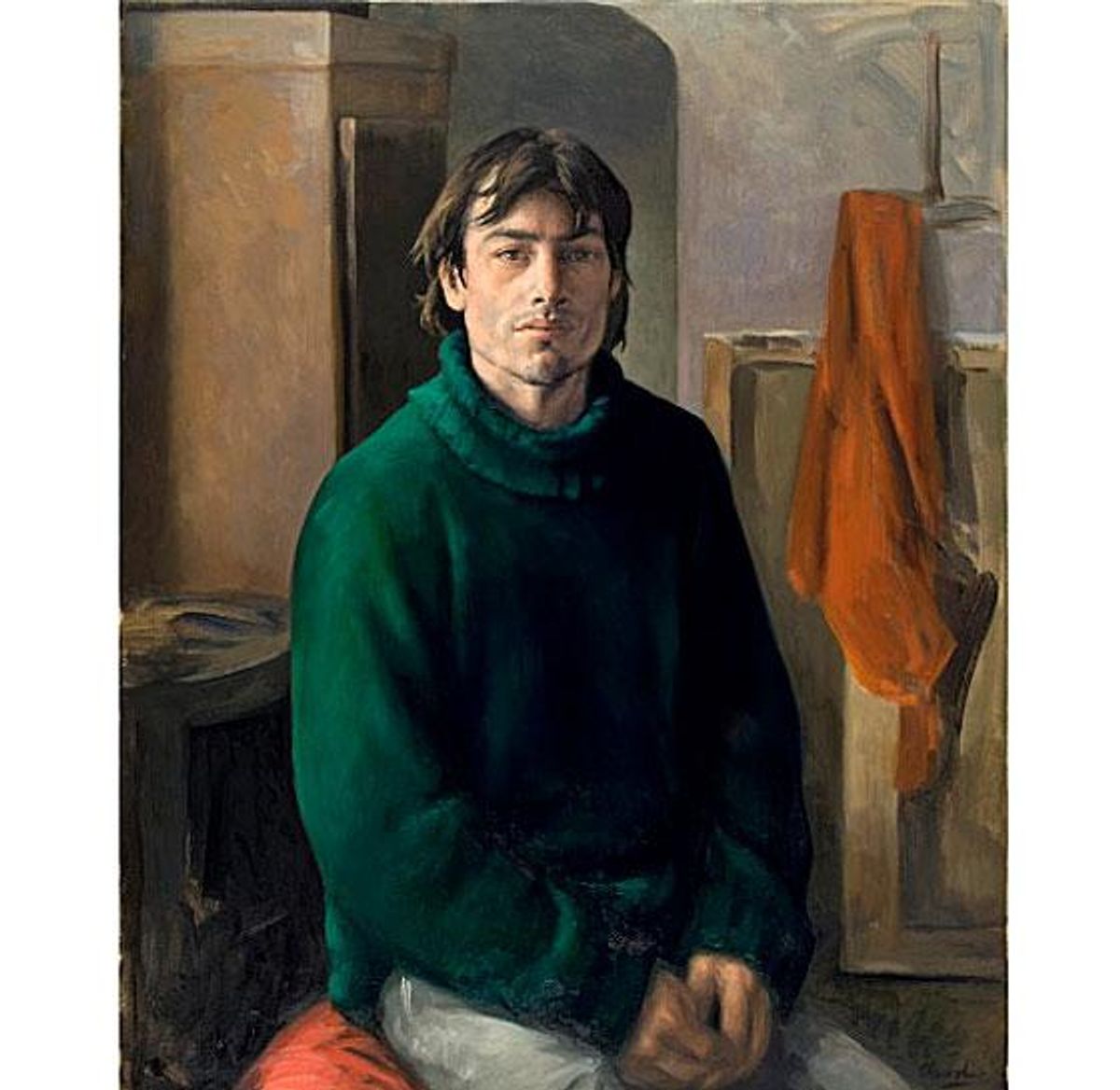
CONTACTStaffCAREER OPPORTUNITIESADVERTISE WITH USPRIVACY POLICYPRIVACY PREFERENCESTERMS OF USELEGAL NOTICE
© 2024 Pride Publishing Inc.
All Rights reserved
All Rights reserved
By continuing to use our site, you agree to our Private Policy and Terms of Use.
Peter Churcher is an Australian artist who decided to relocate to Barcelona in 2006 in order to explore a new culture and further develop themes in his painting. The basic theme of Churcher's paintings is the figure, in both the individual and group narrative context. In moving to Spain, Churcher brought himself closer to the "coalface" of both the European figure painting tradition and the vibrant contemporary human presence that is so alive and active on the streets in a country such as Spain. Churcher has worked through various themes over the past five years in Spain -- the dark religious processions of the Semana Santa (Easter) festivals, the street-kid/skateboard culture of the youths of Barcelona, and most recently, the life of the urban beaches of Barcelona. Each of these themes contrasts in palette and mood, but they are linked by the same highly charged sensuality and sense of "human ritual" that is such a central theme of Churcher's general work practice.
In January 2002, Churcher was appointed by the Australian War Memorial as the nation's official artist for the "war against terrorism" in the Persian Gulf and Afghanistan. All the works were painted on site during the two separate engagements, the first covering the Persian Gulf and the Diego Garcia support facility and the second at Bagram, Afghanistan.
Churcher is represented by Australian Galleries in Melbourne and Sydney and Phillip Bacon Galleries in Brisbane. Churcher also exhibits work in Europe through Mokum Galerie in Amsterdam. Churcher's next show opens August 9 at Australian Galleries in Sydney.
Why are you an artist?
Well, I really had no choice in that. Apart from having an interest in music and learning to play the piano tolerably well, painting was the one thing that I could always do well.
What catches your eye?
I am an artist who relies heavily on walking the streets and keeping an open eye on the human traffic around me. What ultimately catches my eye, and develops into a series of work, is a combination of physical beauty/sexuality, human frailty, playing out of collective ritualized behaviour. These themes I can see in so many different guises and often in quite unexpected ways ... I just have to be open to it and prepared to get it down on the canvas.
Tell us about your process or techniques.
The most basic process, central to my work, is that I work from life. I constantly have models in the studio, and the interaction between myself and the other person in my studio is terribly important. For this reason I can only use photographs in a very limited way. They can only provide me with a memory or rough record of what I have seen. For the painting to have any real electricity, however, I need to re-create the scene with real people in my studio. That's when I get excited by what I am painting. Of course, the photograph can be very helpful in the case of, say, my beach paintings. Even though I was sitting on the beach doing the studies in situ, people basically just don't keep still, even when relaxing and lounging about on the beach! The quick, clandestine photo, however, enables me to capture a moment that I can later use in the studio ... much in the same way the artist's sketchbook operated in the past.
How do you choose your subjects?
I tend to work with the one model, or perhaps two, at any particular time. I like to find that "right" person, and when I do, I stick to it. I find that over a period of time, painting this person again and again, I really get inside this person's psyche and character. Equally, they too get a "sixth sense" of what is going on inside my head when I begin a painting. I find this interaction very exciting and rewarding. Who, or what attributes, does this "right person" have? Hard to say. All I know is that when I see them the first time I get this "sense" that it is going to work. Sometimes, of course, you realize this "sense" was a false alarm once you start the first piece of work and the painting relationship quickly fades away. But more often than not, this first painting is just the beginning of a journey between myself and my model, which evolves into a working relationship that can span many years and manifest itself in many paintings.
How do you describe your work?
Basically from the very outset, when I was in art school and the only means of supposedly relevant artistic expression was the video or installation, I was totally convinced that one could paint oil paintings in a strongly figurative manner with all the relevance and contemporary context as any other medium. My professors at art school often disagreed, but I saw in the "contemporary practice" that was institutionalized at the time an orthodoxy that I could rebel against by sticking stalwartly to my own very strongly held painting principles. I was seen as reactionary and not "with it," but to do anything else would be a lie to me. I can only paint one way, and to let go of that would be death to my relevance as an artist. I have never for one second let go of my conviction that what I am doing is right (for me) and that I must stick to this regardless of whatever art fashion is in place at the time.
What makes a good artwork to you?
Well, as I said above, an artwork that is true to itself, unconscious of "fitting in" with the accepted art dogma of its time, and real. For me, a great artwork is a visceral, emotional/sexual, and very physical revelation of a moment of the world we live in. Concepts and superimposed theories bore me.
What artists do you take inspiration from and why?
Well, those artists that have done exactly what I have described above. Manet, for example, saw in the 17th-century Spanish painters, specifically Velazquez, a way to rediscover the power of painting and overthrow the orthodoxy of the French 19th-century Salon style with all its frilly, overblown decorativeness and "rules" as to what constituted a "good" painting. Manet showed us that there are no "rules," just your own personal inner conviction. Ironically, whilst being totally rejected in his time by the Salon, Manet went on to become titled as "the father of Modernism."
xtyfr
From our Sponsors
Most Popular
31 Period Films of Lesbians and Bi Women in Love That Will Take You Back
December 09 2024 1:00 PM
18 of the most batsh*t things N.C. Republican governor candidate Mark Robinson has said
October 30 2024 11:06 AM
True
After 20 years, and after tonight, Obama will no longer be the Democrats' top star
August 20 2024 12:28 PM
Trump ally Laura Loomer goes after Lindsey Graham: ‘We all know you’re gay’
September 13 2024 2:28 PM
Melania Trump cashed six-figure check to speak to gay Republicans at Mar-a-Lago
August 16 2024 5:57 PM
Latest Stories
Matt Gaetz allegedly paid tens of thousands of dollars for sex and drugs: House Ethics report
December 23 2024 10:41 AM
Freemasons, gay men, and corrupt elites in Cameroon — inside a conspiracy theory
December 21 2024 12:51 PM
Kathy Hochul vetos financial protection bill introduced after murders of gay men
December 21 2024 12:29 PM
35 pics of celebs uniting at David Barton & Susanne Bartsch Toy Drive 2024
December 20 2024 5:01 PM
From Saturnalia to Santa, is Christmas just drag in disguise?
December 20 2024 4:44 PM
Out and About with Billy Eichner
December 20 2024 3:25 PM
Tennessee pizzeria refuses to cater same-sex weddings
December 20 2024 1:43 PM
Meet Bobbie Simpson: California’s first out trans school board member
December 20 2024 12:05 PM
Here are the 30 transgender Americans lost to violence so far this year
December 20 2024 11:12 AM
Trending stories
Recommended Stories for You
Christopher Harrity
Christopher Harrity is the Manager of Online Production for Here Media, parent company to The Advocate and Out. He enjoys assembling online features on artists and photographers, and you can often find him poring over the mouldering archives of the magazines.
Christopher Harrity is the Manager of Online Production for Here Media, parent company to The Advocate and Out. He enjoys assembling online features on artists and photographers, and you can often find him poring over the mouldering archives of the magazines.
















































































Viral post saying Republicans 'have two daddies now' has MAGA hot and bothered